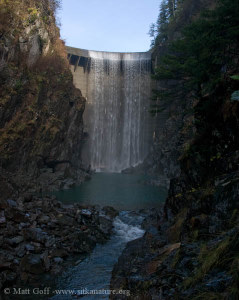Paying higher rates for electricity in Sitka won’t be much fun, but spending that money on the largest public infrastructure project in city history sounds like… well, a blast.
Staff in the municipal electric department outlined the scope of the Blue Lake Hydro expansion project for the Sitka Chamber of Commerce on Wednesday (2-13-13). The work, while dangerous and expensive, is also a complicated engineering puzzle that is much more than a paycheck for the people designing and building it.
Dean Orbison is the engineer in the electrical department who is spearheading the effort to raise the Blue Lake Dam. He could barely contain his enthusiasm for the project. When the dam was first built a half-century ago, the engineers at the time planned for it to one day be raised.“If you build the dam bigger than you need, you pay for it earlier than you want to. Let’s design it so that someone down the road can raise it another 23 feet, which is right up to here (points to diagram). So they designed it so that it can be done, and that’s how we can pull this off.”
Pull it off, and then some. The new design calls for raising the dam 83 feet — 60 feet more than the builders intended. The completed dam will go to the very top of the canyon. This increased water height — or head — is where the increased power comes from, not from the increased amount of water in the lake.
“That’s how you make the electricity. We’re using the same amount of water that’s falling into the lake every year for the last fifty years. All we’re doing is using it at a higher elevation, so that we can generate more energy with it.”
Construction began on November 1. Orbison said, “We’ve been up there blowing stuff up since then.” Crews have cleared and leveled a 2-acre site at the end of Blue Lake Road to stage construction materials, and to assemble one very, very large piece of equipment.
“This is the largest crane in the state of Alaska. This crane will sit on the right abutment here, and it will reach all the way across the dam to the left abutment. It’s huge. It’s like nothing I’ve ever seen before.”
The crane is being hauled up the Blue Lake Road in pieces, each on its own flatbed truck. Orbison put up a picture of the operation. A worker standing on the ground is dwarfed by one of the crane’s giant tracks.
Besides the dam itself, crews will spend the next year constructing a new powerhouse to hold three new 5 megawatt turbines. The old powerhouse, with its pair of 3 megawatt turbines, will be converted into shop space. A new penstock, or pipeline, will connect the powerhouse to the rock tunnel that carries the water out of the lake. Upstream, crews will bore a new intake into the lake, and connect it to the tunnel near where it emerges as a large pipeline in the Blue Lake campground. And those same miners are blasting a vertical shaft, called a surge chamber, through solid rock to the tunnel to absorb changes in pressure — called water hammer — when valves are closed in the powerhouse.
In a new project, all this work could happen on a straight timeline. Not so with Blue Lake. Except for a two-month period in the fall of 2014, when water is diverted into the new powerhouse for testing, the old Blue Lake turbines will keep powering Sitka during the entire project. Managing power supply and construction at the same time is a big part of what Orbison called “the game.”
“Everything that we’re doing here is determined not by when we can get the equipment delivered, or when we get our act together on putting it in. It’s controlled by the lake levels.”
Orbison said that the electric department would impose a temporary rate hike during the planned outage in 2014, as a way of controlling demand. Using price in this way is a relatively recent development in Sitka. And while the Blue Lake project will provide relief from an overall power shortage here, Orbison suggested that the new supply of inexpensive power from Blue Lake was a windfall to be managed carefully.
“If you convert your house from oil heat to electric heat, you can use up this project in a heartbeat. Our plan is to get you to do that for twenty years, until its gone. And then we’ll cut you off!… Right, Chris?”
That’s Orbison turning to Utility Director Christopher Brewton. Brewton, and contract project manager Richard Linden also spoke to the chamber. Brewton referred to the Blue Lake expansion as “a second chance for energy independence” in Sitka. He hoped that twenty years from now a future utility director would speak to the chamber and compliment citizens of today for their foresight in building the Blue Lake project, while also adopting the energy efficiency standards to make the project more than a short-term fix for unchecked growth in electric demand.
































